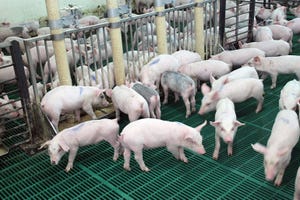Legislative Watch: Trump's proposes $4.4 trillion budget, major cuts to agriculture and nutrition in FY19 Budget and Farm Act exempts producers from animal emissions reporting.

President Trump released the administration’s $4.4 trillion the Fiscal Year 2019 proposed budget, “An American Budget,” that indicates the administration’s priorities for the coming fiscal year. The budget increases spending for defense, infrastructure and a border wall. The administration says it is proposing major cuts to government programs that it views as wasteful. The proposed budget is not a balanced budget. In fact, it estimates the national deficit will increase $7.2 trillion over the next 10 years.
On infrastructure, the budget proposes spending $200 billion over 10 years to help leverage investments from state and local governments and the private sector to support $1.5 trillion on infrastructure. Rural infrastructure and internet access would receive 25% of the proposed $200 billion which would be given to states for infrastructure projects. Congressman Bill Shuster (R-PA), chairman of the House Transportation and Infrastructure Committee, voiced concerns the proposal was relying too much on states for funding which he believes many could not afford.
The administration is proposing major cuts in domestic programs including $500 billion from Medicaid over 10 years. NASA’s International Space Station would be run by the private sector starting in 2025.
President’s budget proposes major cuts for agriculture and nutrition
The budget proposes cutting farm programs by $47 billion over 10 years with the majority of the cuts coming from the crop insurance program. The Supplemental Nutrition Assistance Program would be reduced and significantly restructured. It also eliminates some USDA programs.
The administration’s budget summary says for agriculture it would “maintain a strong safety net for farmers while achieving savings by eliminating subsidies to higher income farmers, reducing overly generous crop insurance subsidies to producer and companies, and by eliminating some programs that have no federal purpose.”
Crop insurance: The budget proposes cutting crop insurance by $22 billion over 10 years. Crop insurance premium subsidies would be reduced from 62% currently to 48%. Insurance companies underwriting gains would be capped at 12% which would result in saving $3 billion over 10 years.
Means testing: Producers with an adjusted gross income of more than $500,000 would not be eligible to receive commodity payments and conservation program benefits.
SNAP: The administration is proposing major cuts to the Supplemental Nutrition Assistance Program and replacing some of the cuts with a box of canned products. The budget would cut the SNAP program by $17 billion in FY ’19 and more than $213 billion over 10 years.
SNAP recipients now receive their benefits through an electronic benefits card that can be used at approved food stores. Under the proposed budget, households that receive more than $90 per month in SNAP benefits would receive half of their benefits in the form of a USDA food package that would include such items as shelf-stable milk, breakfast cereal, pasta, peanut butter, beans, and canned fruit, vegetables, and meat, poultry, and fish. This would affect 16.4 million households or 81% of SNAP households.
CRP: The budget proposes limiting Conservation Reserve Program enrollment to whole farm fields, except for grasslands. CRP payments would be limited to 80% of local rental rates.
USDA programs eliminated: Some USDA programs would be eliminated under the administration’s budget. Those include the Livestock Forage Program (disaster assistance program), Rural Business and Cooperative Programs, Rural Water and Wastewater Grants, Single Family Housing Direct Loan Program, and the McGovern-Dole international school-feeding program,
User fees: The budget proposes some user fees to pay for USDA programs. The Food Safety and Inspection Service will propose legislation to allow for a user fee to cover all domestic inspection, import re-inspection, and most of the central operations costs for federal, state, and international inspection programs for meat, poultry and egg production. The budget proposes a Packers and Stockyards licensing fee to cover the costs of Packer and Stockyard programs. Animal and Plant Health Inspection Service user fees would be established to offset costs related to the enforcement of the Animal Welfare Act; regulation of biotechnology-derived products; and regulation of veterinary biologics products.
Congressional agricultural leaders were swift in letting their feelings be known on the proposed budget. The president can propose, but it will be the Senate and House Agriculture Committees that will decide. The vast majority of the president’s proposed cuts for agriculture and nutrition will be rejected. However, the opponents of agriculture will use these proposals to go after the farm bill.
Sen. Pat Roberts (R-KS), chairman of the Senate Agriculture Committee and Congressman Mike Conaway (R-TX) released a joint statement saying, “As chairmen of the Agriculture Committees, the task at hand is to produce a farm bill for the benefit of our farmers, ranchers, consumers and other stakeholders. This budget, as with every other president’s budget before, will not prevent us from doing that job. We are committed to maintaining a strong safety net for agricultural producers during these times of low prices and uncertain markets and continuing to improve our nation’s nutrition programs.”
Sen. Debbie Stabenow (D-MI), the ranking member of the Senate Agriculture Committee, says, “The proposed cuts to both the USDA and the farm bill would hurt American agriculture, neglect rural businesses, and leave families and seniors behind. This is especially troubling given the state of the fragile rural economy. If taken seriously, this budget would make it impossible for Congress to pass a farm bill this year.”
Farm Act exempts producers from animal emissions reporting
Sens. Deb Fischer (R-NE) and Joe Donnelly (D-IN), along with 18 Senators, have introduced the bipartisan “Fair Agricultural Reporting Method Act.” The legislation returns the exemption for air emissions from animal waste on a farm from reporting requirements under the Comprehensive Environmental Response, Compensation & Liability Act or Superfund. Livestock producers are facing a May 1 court deadline to comply with CERCLA.
The bill would:
• Maintain the exemption for certain federally registered pesticides from reporting requirements within CERCLA.
• Exempt air emissions from animal waste on a farm from reporting requirements under CERCLA.
• Provide agriculture producers with greater certainty by reinstating the status quo producers have been operating under since the Environmental Protection Agency’s 2008 final rule.
The FARM Act is supported by the National Cattlemen’s Beef Association, National Chicken Council, National Pork Producers Council and National Turkey Federation.
About the Author(s)
You May Also Like



